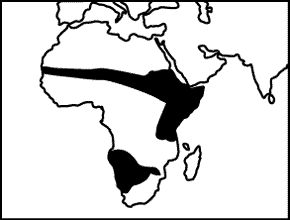 Ostriches consist of a single species with six subspecies, of which one, the Arabian
ostrich, became extinct in 1941.
Ostriches consist of a single species with six subspecies, of which one, the Arabian
ostrich, became extinct in 1941.
 Ostriches consist of a single species with six subspecies, of which one, the Arabian
ostrich, became extinct in 1941.
Ostriches consist of a single species with six subspecies, of which one, the Arabian
ostrich, became extinct in 1941.
The ostrich is the largest living bird, standing up to 2.5 m tall and weighing up to 135 kg. Much of its height is due to its long neck and legs. Ostriches have excellent vision and can run at up to 65 km per hour.
Wild ostriches are common today only in parts of East Africa, although until early in the 20th century they were found in many parts of Africa and southwest Asia. Ostriches are also farmed in S. Africa, Australia, and N. America for their plumage, leather, and meat.
Ostriches consume mainly vegetation, although they may also eat invertebrates and small vertebrates such as lizards. The birds also swallow grit and stones to aid in digestion.
Ostriches are polygamous, with multiple females in association with one male. The birds dig a shallow pit in sandy soil, into which all the females of a family deposit their eggs. The total number of eggs ranges from 15 to 60. The incubation period is 40 days. The male incubates at night, and the females during the day. Many eggs do not hatch.
